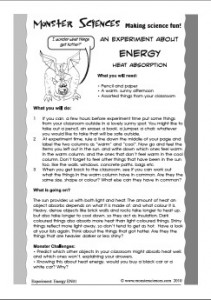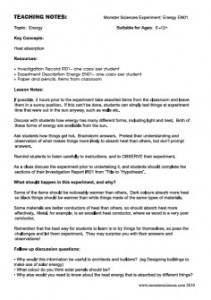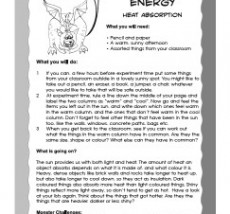Begin a study on energy by exploring some of the factors (such as colours and materials) that affect how objects absorb heat.
 |
 |
Energy Science Experiment: Heat Absorption
What you will need:
- Pencil and paper
- A warm, sunny afternoon
- Assorted things from your classroom
What you will do:
1 If you can, a few hours before experiment time put some things from your classroom outside in a lovely sunny spot. You might like to take out a pencil, an eraser, a book, a jumper, a chair, whatever you would like to take that will be safe outside.
2 At experiment time, rule a line down the middle of your page and label the two columns as “warm” and “cool”. Now go and feel the items you left out in the sun, and write down which ones feel warm in the warm column, and the ones that don’t feel warm in the cool column. Don’t forget to feel other things that have been in the sun too, like the walls, windows, concrete paths, bags etc.
3 When you get back to the classroom, see if you can work out what the things in the warm column have in common. Are they the same size, shape or colour? What else can they have in common?
What is going on?
The sun provides us with both light and heat. The amount of heat an object absorbs depends on what it is made of, and what colour it is. Heavy, dense objects like brick walls and rocks take longer to heat up, but also take longer to cool down, so they act as insulation. Dark coloured things also absorb more heat than light coloured things. Shiny things reflect more light away, so don’t tend to get as hot.
Have a look at your lists again. Think about the things that got hotter. Are they the things that are heavier, darker or less shiny?
Monster Challenges:
- Predict which other objects in your classroom might absorb heat well, and which ones won’t, explaining your answers.
- Knowing this about heat energy, would you buy a black car or a white car? Why?
Teaching Notes: Monsters Experiment: Energy EN01
Topic:
Energy
Key Concepts:
Heat Absorption
Resources:
- Investigation Record IR01– one copy per student
- Experiment Description Energy EN01– one copy per student
- Paper and pencils, items from classroom
Lesson Notes:
If possible, 2 hours prior to the experiment take assorted items from the classroom and leave them in a sunny position. If this can’t be done, students can simply test things at experiment time that were out in the sun anyway, such as walls etc.
Discuss with students how energy has many different forms, including light and heat. Both of these forms of energy are available from the sun.
Ask students how things get hot. Brainstorm answers. Pretest their understanding and observation of what makes things more likely to absorb heat than others, but don’t prompt answers.
Remind students to listen carefully to instructions, and to OBSERVE their experiment.
As a class discuss the experiment prior to undertaking it, and students should complete the sections of their Investigation Report IR01 from ”Title to “Hypothesis”.
What should happen in this experiment, and why?
Some of the items should be noticeably warmer than others. Dark colours absorb more heat so black things should be warmer than white things made of the same types of materials.
Some materials are better conductors of heat than others, so should absorb heat more effectively. Metal, for example, is an excellent heat conductor, where as wood is a very poor conductor.
Remember that the best way for students to learn is to try things for themselves, so pose the challenges and let them experiment. They may surprise you with their answers and observations!
Follow up discussion questions:
- Why would this information be useful to architects and builders? (eg Designing buildings to make use of solar energy)
- What colour do you think solar panels should be?
- Why else would you need to know about the heat energy that is absorbed by different things?



